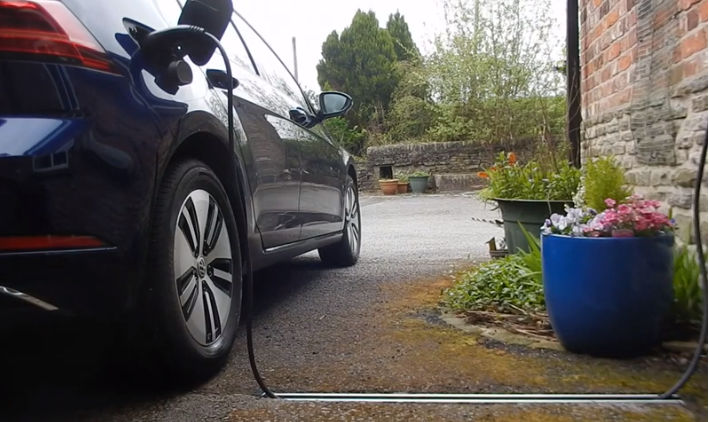Back in February 2020, after owning an e-Golf for a few months, Colin Townend (a retired Chartered Engineer from Macclesfield) realised there was a need other than simply more public charging points.
Colin felt there was a need to make it easier for people to charge their cars from home, safely and without the charging cables becoming a trip hazard, especially if they had to be passed across a pavement.
The electricity used to cover the average UK mileage of 22 miles per day is easily replaced in a few hours from a domestic 13 amp socket, and a ‘proper’ home charge point is 3.5 times faster.
Not only is home charging the cheapest (by a factor of four if off-peak electricity is used), but it is also the most convenient:
- Just plug the car in when you get home and forget about it
- No searching for a nearby, unoccupied charge point
- No obligation to move the car after charge complete to allow others to use it
- Most able to use surplus overnight (renewable) energy e.g. wind power
- Some cars will be able to feed power back into the grid when demand is at its highest.

So, rather than the provision of more public charge points, Colin felt that the problem that really needed fixing was how owners without off-street parking could charge their cars at home without tripping people up with their cables crossing the pavement.
Sign-up to Electric Road now to receive a FREE ‘Guide to the Best Electric Cars’, a weekly Newsletter and to win some great prizes!
Colin went to bed one night thinking about running cables high above the pavement but realised someone would swing on them! He woke up with the idea of a channel in the pavement and a brush strip to stop the cable popping back up.

To his wife’s bemusement, he got up, went outside and made the wooden prototype you can see below using a Stormguard draught excluder. It seemed to work well but Colin felt an aluminium extrusion would be preferable. Then he realised Stormguard’s threshold products use such extrusions and brush strips and they also sell to DIY stores and builders’ merchants.
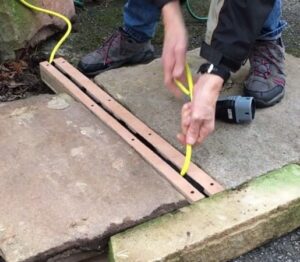
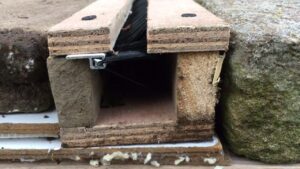
So Colin presented the idea to Stormguard and they liked it immediately but getting into production took two years due to Covid and the pressures of other work.
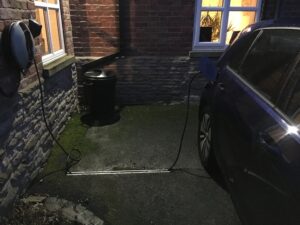
When Stormguard took over, the profile didn’t change much from Colin’s original design but the design benefited from their experience of dimensional tolerances and the selection of the brush bristle material.
The product is made in 3 metre lengths and cut down to 1 metre for ease of shipping, so it could be supplied longer on request. Furthermore, by offsetting the brushes by a few millimetres, Colin & Stormguard realised that for those requiring longer gullies, two lengths could be clipped together like model train tracks.
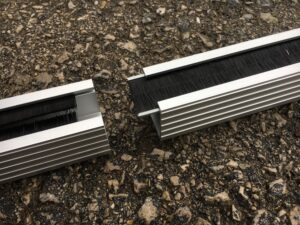
An initial batch of 300 was produced and more are now on order. They are still in the process of recruiting distributors but approximately a 100 units have been sold so far.
In terms of where the product can go next, Colin & Stormguard have had messages of intent from some big property developers to use the product on new-build domestic driveways where the building regulations now require them to install EV charge points.
Local authorities are clearly in their sights given that they ‘own’ the pavement as part of the highway. The local authorities are responsible for avoiding unnecessary disruption to the surface and the services that lie below. However, the councils know that when electric cars become predominant, they will attract a huge wave of requests and Stormguard are hoping that their product will become a permitted development.
Local authorities also have a system of licensing charges to changes made on highways such as installing dropped kerbs and these fees can be hundreds of pounds. However, some authorities are working on this issue and are thinking they could possibly have a ‘lite’ licence fee. Some authorities think they would have to use their own contractor to install the gullies.
Colin is hoping that the shallow depth needed for his product and the recommended use of a self depth-limiting angle grinder, might persuade some authorities to permit some charge point installers to make this part of their job. It requires only a 5cm wide and 5cm deep channel to be cut in the pavement with an angle-grinder, minimising the surface disturbance and unlikely to interfere with any underground services. The installation can be extremely quick, typically less than one hour, so any disruption of pedestrian traffic would be minimal. Cheshire East are planning an evaluation trial later this year.
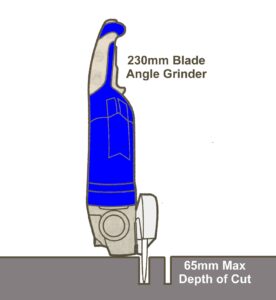
For Colin, the main priorities right now are to publicise the product, demonstrate that the demand exists and to work with charge point manufacturers and councils to get the product installed.
One-metre lengths are only £34.99 and are available from lowenergysupermarket.com, Amazon and ebay. Two metre and three metre lengths are also available from Stormguard – Part No: 04CP905, tel: 01625 613311.
For more information please visit – https://www.maccinfo.com/Stormguard/


